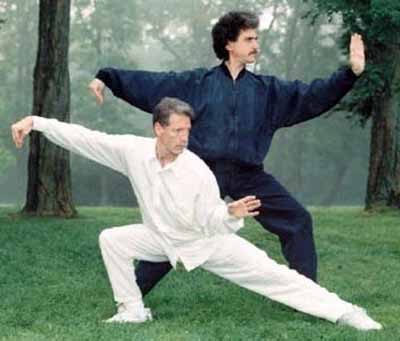

Tai Chi Chuan is an internal Chinese martial art practiced for both its defense training and its health benefits. It is also typically practiced for a variety of other personal reasons: its hard and soft martial art technique, demonstration competitions, and longevity. As a consequence, a multitude of training forms exist, both traditional and modern, which correspond to those aims. Some of tai chi chuan's training forms are especially known for being practiced at what most people categorize as slow movement.
Tai Chi is a centuries old Chinese discipline for health, relaxation, balance, flexibility, strength, meditation, self-defense and self-cultivation. It improves circulation, balance, coordination, and helps relax and strengthen the muscular and nervous systems. The stretching movements make the body limber, tone up muscles, and help release tension.
As a meditation, Tai Chi is a way of harmonizing body and mind dynamically and is sometimes referred to as 'moving meditation'. The mind should be as still as if you are in sitting meditation, but you should still be able to actively circulate your Chi.
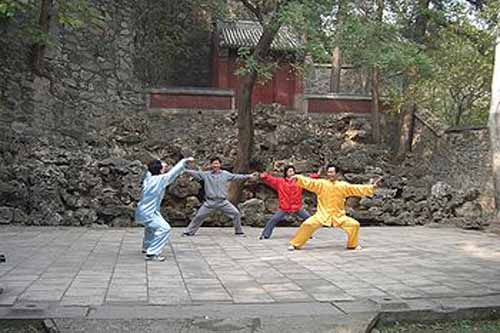
There are five major styles of tai chi chuan, each named after the Chinese family from which it originated:
The order of verifiable age is as listed above. The order of popularity (in terms of number of practitioners) is Yang, Wu, Chen, Sun, and Wu/Hao. The major family styles share much underlying theory, but differ in their approaches to training.
There are now dozens of new styles, hybrid styles, and offshoots of the main styles, but the five family schools are the groups recognized by the international community as being the orthodox styles. Other important styles are Zhaobao Tai Chi, a close cousin of Chen style, which has been newly recognized by Western practitioners as a distinct style, and the Fu style, created by Fu Chen Sung, which evolved from Chen, Sun and Yang styles, and also incorporates movements from Pa Kua Chang.
All existing styles can be traced back to the Chen-style, which had been passed down as a family secret for generations. The Chen family chronicles record Chen Wangting, of the family's 9th generation, as the inventor of what is known today as Tai Chi.
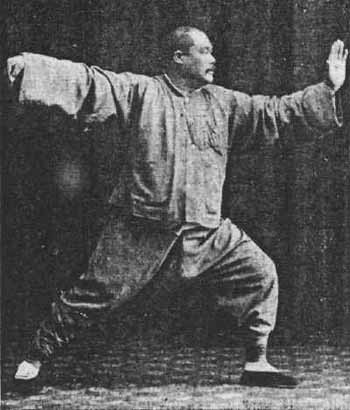
Yang Lu-ch'an became the first person outside the family to learn Tai Chi. His success in fighting earned him the nickname "Unbeatable Yang", and his fame and efforts in teaching greatly contributed to the subsequent spreading of Tai Chi knowledge.
When tracing tai chi chuan's formative influences to Taoist and Buddhist monasteries, there seems little more to go on than legendary tales from a modern historical perspective, but tai chi chuan's practical connection to and dependence upon the theories of Sung dynasty Neo-Confucianism (a conscious synthesis of Taoist, Buddhist and Confucian traditions, especially the teachings of Mencius) is claimed by some traditional schools.
Tai chi's theories and practice are believed by these schools to have been formulated by the Taoist monk Zhang Sanfeng in the 12th century, at about the same time that the principles of the Neo-Confucian school were making themselves felt in Chinese intellectual life.
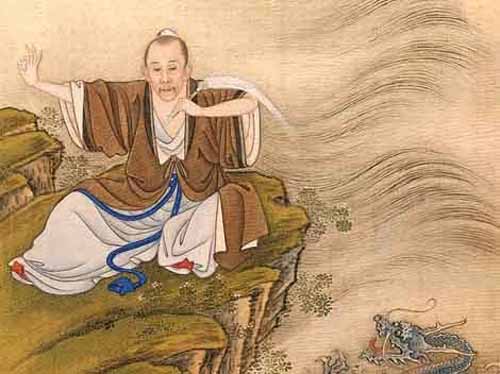
However, modern research casts serious doubts on the validity of those claims, pointing out that a 17th-century piece called "Epitaph for Wang Zhengnan" (1669), composed by Huang Zongxi (1610-1695 A.D.), is the earliest reference indicating any connection between Zhang Sanfeng and martial arts whatsoever, and must not be taken literally but must be understood as a political metaphor instead. Claims of connections between Tai Chi and Zhang Sanfeng appear no earlier than the 19th century.
These family trees are not comprehensive. Names denoted by an asterisk are legendary or semi-legendary figures in the lineage; while their involvement in the lineage is accepted by most of the major schools, it is not independently verifiable from known historical records. The Cheng Man-ch'ing and Chinese Sports Commission short forms are derived from Yang family forms, but neither is recognized as Yang family tai chi chuan by standard-bearing Yang family teachers. The Chen, Yang, and Wu families are now promoting their own shortened demonstration forms for competitive purposes.
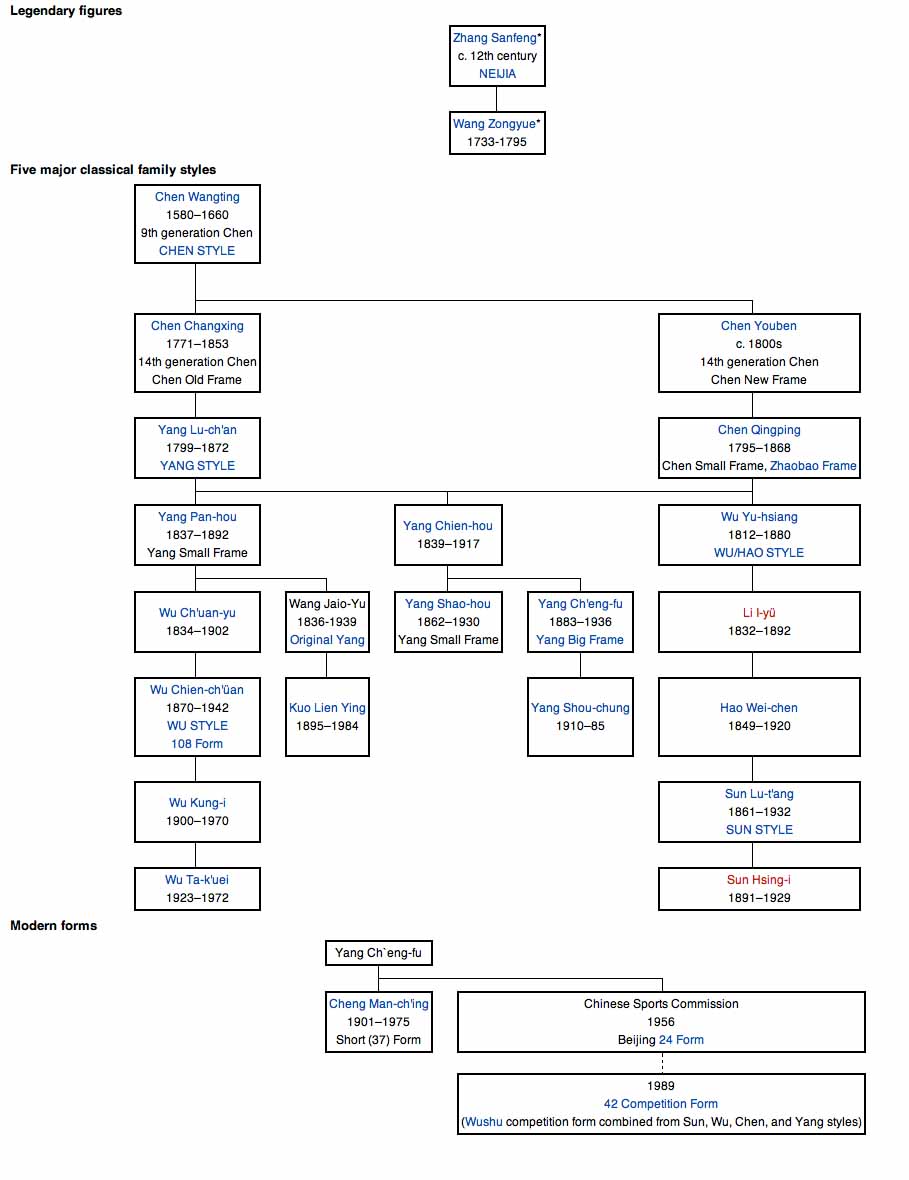
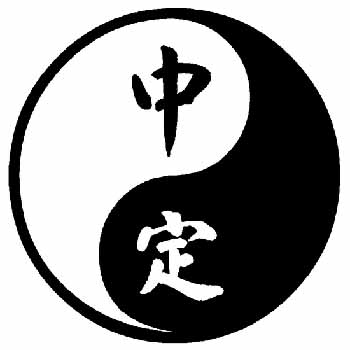
As the name "tai chi chuan" is held to be derived from the Taiji symbol (Taijitu or T'ai chi t'u), commonly known in the West as the "yin-yang" diagram, tai chi chuan is, therefore, said in literature preserved in its oldest schools to be a study of yin (receptive) and yang (active) principles, using terminology found in the Chinese classics, especially the I Ching and the Tao Te Ching.
The core training involves two primary features: the first being the solo form (ch'uan or can), a slow sequence of movements which emphasize a straight spine, abdominal breathing and a natural range of motion; the second being different styles of pushing hands (tui shou) for training movement principles of the form with a partner and in a more practical manner.
The solo form should take the students through a complete, natural range of motion over their center of gravity. Accurate, repeated practice of the solo routine is said to retrain posture, encourage circulation throughout the students' bodies, maintain flexibility through their joints, and further familiarize students with the martial application sequences implied by the forms.
The major traditional styles of tai chi have forms that differ somewhat in terms of aesthetics, but there are also many obvious similarities that point to their common origin. The solo forms - empty-hand and weapon - are catalogs of movements that are practiced individually in pushing hands and martial application scenarios to prepare students for self-defense training. In most traditional schools, different variations of the solo forms can be practiced: fast-slow, small circle-large circle, square-round (which are different expressions of leverage through the joints), low-sitting/high-sitting (the degree to which weight-bearing knees are kept bent throughout the form), for example.
The philosophy of Tai Chi Chuan is that, if one uses hardness to resist violent force, then both sides are certain to be injured at least to some degree. Such injury, according to tai chi theory, is a natural consequence of meeting brute force with brute force. Instead, students are taught not to directly fight or resist an incoming force, but to meet it in softness and follow its motion while remaining in physical contact until the incoming force of attack exhausts itself or can be safely redirected, meeting yang with yin. Done correctly, this yin/yang or yang/yin balance in combat, or in a broader philosophical sense, is a primary goal of tai chi chuan training. Lao Tzu provided the archetype for this in the Tao Te Ching when he wrote, "The soft and the pliable will defeat the hard and strong."
Tai chi's martial aspect relies on sensitivity to the opponent's movements and center of gravity dictating appropriate responses. Effectively affecting or "capturing" the opponent's center of gravity immediately upon contact is trained as the primary goal of the martial tai chi student.
The sensitivity needed to capture the center is acquired over thousands of hours of first yin (slow, repetitive, meditative, low-impact) and then later adding yang ("realistic," active, fast, high-impact) martial training through forms, pushing hands, and sparring. Tai chi trains in three basic ranges: close, medium and long, and then everything in between. Pushes and open-hand strikes are more common than punches, and kicks are usually to the legs and lower torso, never higher than the hip, depending on style.
The fingers, fists, palms, sides of the hands, wrists, forearms, elbows, shoulders, back, hips, knees, and feet are commonly used to strike, with strikes to the eyes, throat, heart, groin, and other acupressure points trained by advanced students. Joint traps, locks, and breaks (chin na) are also used. Most tai chi teachers expect their students to thoroughly learn defensive or neutralizing skills first, and a student will have to demonstrate proficiency with them before offensive skills will be extensively trained. There is also an emphasis in the traditional schools in which one is expected to show wu te, martial virtue or heroism, to protect the defenseless, and show mercy to one's opponents.
In addition to the physical form, martial tai chi chuan schools also focus on how the energy of a strike affects the other person. A palm strike that looks to have the same movement may be performed in such a way that it has a completely different effect on the target's body. A palm strike that could simply push the opponent backward, could instead be focused in such a way as to lift the opponent vertically off the ground, breaking his/her center of gravity; or it could terminate the force of the strike within the other person's body with the intent of causing internal damage.
With purely a health emphasis, Tai chi classes have become popular in hospitals, clinics, and community and senior centers in the last twenty years or so, as baby boomers age and the art's reputation as a low-stress training for seniors became better known.
As a result of this popularity, there has been some divergence between those that say they practice tai chi primarily for self-defense, those that practice it for its aesthetic appeal, and those that are more interested in its benefits to physical and mental health. The wushu aspect is primarily for show; the forms taught for those purposes are designed to earn points in competition and are mostly unconcerned with either health maintenance or martial ability. More traditional stylists believe the two aspects of health and martial arts are equally necessary: the yin and yang of tai chi chuan. The tai chi "family" schools, therefore, still present their teachings in a martial art context, whatever the intention of their students in studying the art.
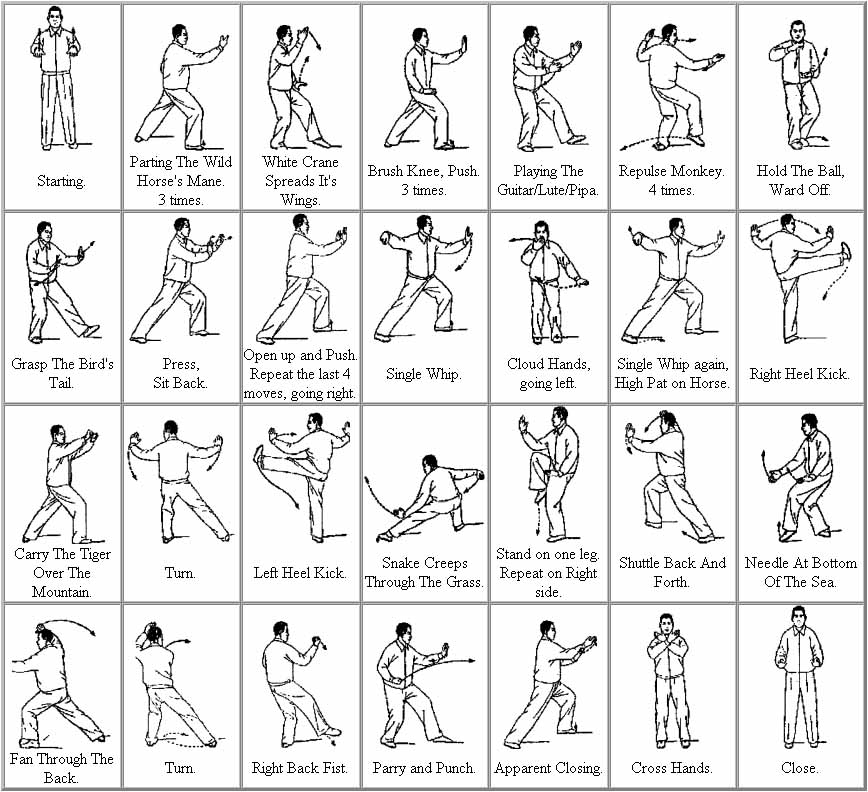
In order to standardize tai chi chuan for wushu tournament judging, and because many tai chi chuan teachers had either moved out of China or had been forced to stop teaching after the Communist regime was established in 1949, the government sponsored the Chinese Sports Committee, who brought together four of their wushu teachers to truncate the Yang family hand form to 24 postures in 1956.
They wanted to retain the look of tai chi chuan but create a routine that would be less difficult to teach and much less difficult to learn than longer (in general, 88 to 108 posture), classical, solo hand forms. In 1976, they developed a slightly longer form also for the purposes of demonstration that still would not involve the complete memory, balance, and coordination requirements of the traditional forms.
This became the Combined 48 Forms that were created by three wushu coaches, headed by Professor Men Hui Feng. The combined forms were created based on simplifying and combining some features of the classical forms from four of the original styles: Chen, Yang, Wu, and Sun.
As tai chi again became popular on the mainland, more competitive forms were developed to be completed within a six-minute time limit. In the late-1980s, the Chinese Sports Committee standardized many different competition forms. They developed sets to represent the four major styles as well as combined forms.
These five sets of forms were created by different teams, and later approved by a committee of wushu coaches in China. All sets of forms thus created were named after their style, e.g., the Chen Style National Competition Form is the 56 Forms, and so on.
The combined forms are The 42-Form or simply the Competition Form. Another modern form is the 67 movements Combined Tai-Chi Chuan form, created in the 1950s; it contains characteristics of the Yang, Wu, Sun, Chen, and Fu styles blended into a combined form. The wushu coach Bow Sim Mark is a notable exponent of the 67 Combined.
These modern versions of tai chi chuan (sometimes listed using the pinyin romanization Tai ji quan) have since become an integral part of international wushu tournament competition, and have been featured in popular movies starring or choreographed by well-known wushu competitors, such as Jet Li and Donnie Yen.
In the 11th Asian Games of 1990, wushu was included as an item for competition for the first time with the 42-Form being chosen to represent tai chi. The International Wushu Federation (IWUF) applied for wushu to be part of the Olympic games, but will not count medals.
Practitioners also test their practical martial skills against students from other schools and martial arts styles in pushing hands and sanshou competition.
Before tai chi's introduction to Western students, the health benefits of Tai Chi Chuan were largely explained through the lens of traditional Chinese medicine, which is based on a view of the body and healing mechanisms not always studied or supported by modern science. Today, tai chi is in the process of being subjected to rigorous scientific studies in the West.
Now that the majority of health studies have displayed a tangible benefit in some areas to the practice of tai chi, health professionals have called for more in-depth studies to determine mitigating factors such as the most beneficial style, suggested duration of practice to show the best results, and whether tai chi is as effective as other forms of exercise.
Researchers have found that intensive tai chi practice shows some favorable effects on the promotion of balance control, flexibility, cardiovascular fitness, and has shown to reduce the risk of falls in both healthy elderly patients, and those recovering from chronic stroke, heart failure, high blood pressure, heart attacks, multiple sclerosis, Parkinson's, Alzheimer's and fibromyalgia, Tai chi's gentle, low impact movements burn more calories than surfing and nearly as many as downhill skiing.
Tai chi, along with yoga, has reduced levels of LDLs 20-26 milligrams when practiced for 12-14 weeks. A thorough review of most of these studies showed limitations or biases that made it difficult to draw firm conclusions on the benefits of tai chi.
A later study led by the same researchers conducting the review found that tai chi (compared to regular stretching) showed the ability to greatly reduce pain and improve overall physical and mental health in people over 60 with severe osteoarthritis of the knee.
In addition, a pilot study, which has not been published in a peer-reviewed medical journal, has found preliminary evidence that tai chi and related qigong may reduce the severity of diabetes.
In a randomized trial of 66 patients with fibromyalgia, the tai chi intervention group did significantly better in terms of pain, fatigue, sleeplessness and depression than a comparable group given stretching exercises and wellness education.
A recent study evaluated the effects of two types of behavioral intervention, tai chi and health education, on healthy adults, who, after 16 weeks of the intervention, were vaccinated with VARIVAX, a live attenuated Oka/Merck Varicella zoster virus vaccine.
The tai chi group showed higher and more significant levels of cell-mediated immunity to varicella zoster virus than the control group that received only health education. It appears that tai chi augments resting levels of varicella zoster virus-specific cell-mediated immunity and boosts the efficacy of the varicella vaccine. Tai chi alone does not lessen the effects or probability of a shingles attack, but it does improve the effects of the varicella zoster virus vaccine.
There have also been indications that tai chi might have some effect on noradrenaline and cortisol production with an effect on mood and heart rate. However, the effect may be no different than those derived from other types of physical exercise. In one study, tai chi has also been shown to reduce the symptoms of Attention Deficit and Hyperactivity Disorder (ADHD) in 13 adolescents. The improvement in symptoms seem to persist after the tai chi sessions were terminated.
In June, 2007 the United States National Center for Complementary and Alternative Medicine published an independent, peer-reviewed, meta-analysis of the state of meditation research, conducted by researchers at the University of Alberta Evidence-based Practice Center.

The report reviewed 813 studies (88 involving Tai Chi) of five broad categories of meditation: mantra meditation, mindfulness meditation, yoga, Tai Chi, and Qi Gong. The report concluded that "the therapeutic effects of meditation practices cannot be established based on the current literature," and "firm conclusions on the effects of meditation practices in healthcare cannot be drawn based on the available evidence.